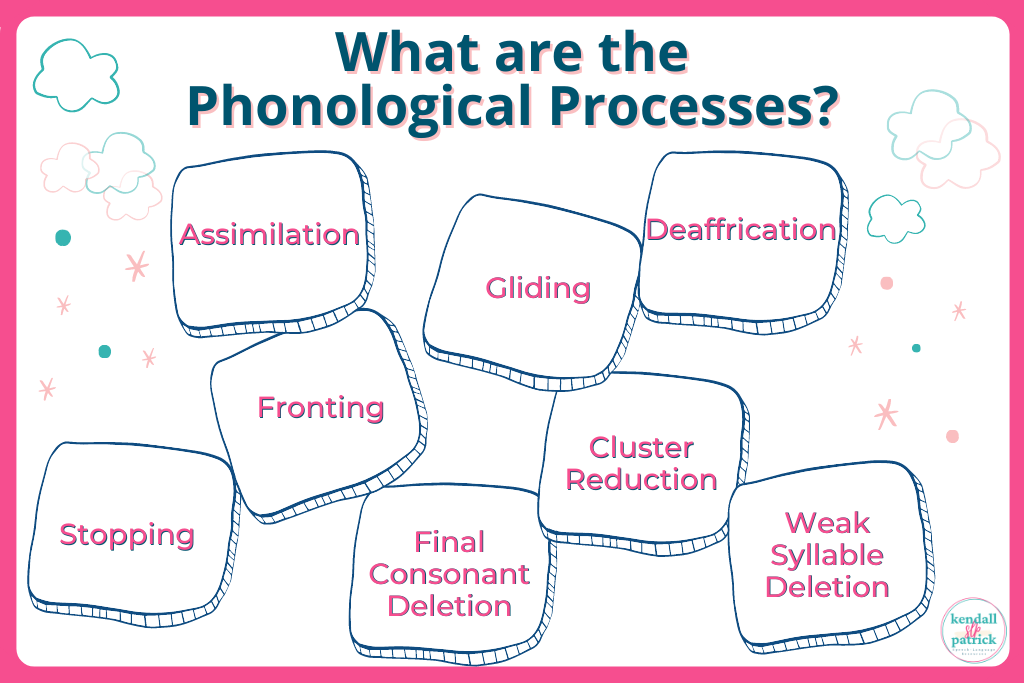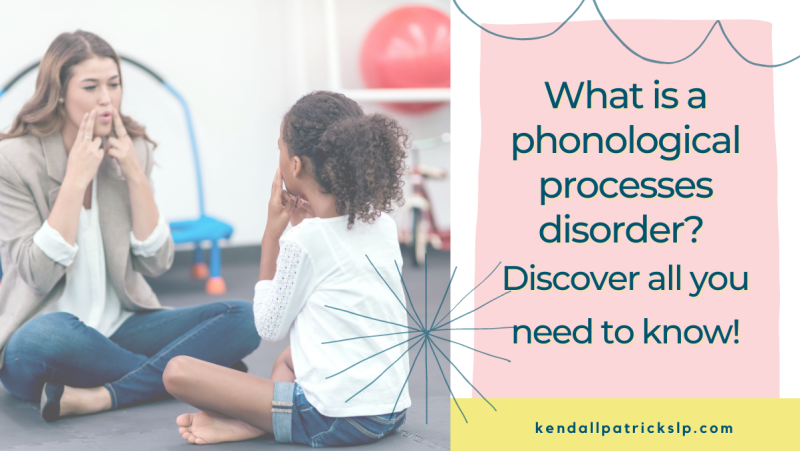I’ve talked a bit about phonological processes and ways to treat them in previous posts. Check out my blog post on different therapy approaches here. Phonological processes disorders differ from an articulation disorder (a motor-based sound disorder); however, the two can co-occur. Phonological processes disorders are actually language-based disorders that occur at the phonemic level. Therefore, children with phonological processes disorder need to learn to organize their sounds into a system in order to use them correctly in connected speech. Often times, these children struggle with phonemic awareness and research shows that difficulty in these areas is a strong predictor of poor reading and spelling development. his greatly supports the need to intervene early to treat phonological processes disorders. In order to do that, we need to know what they look like and what typical development looks like.
Immediate access to all my favorite freebies here:
What is a Phonological Processes Disorder?
Here’s a quick look into my life currently. I have a wild little 3-year-old guy who is wide-open all the time. But in addition, he is also precious, sweet, snuggly, and all those good things too! And, he, like most 3-year-olds, can be hard to understand at times.
Now, since his mama is an SLP, he has already been informally “evaluated,” and his speech is fairly typical for his age. But, that doesn’t mean his errors don’t cause some issues at times. For example, one pattern in his speech right now is – cluster reduction. Those tricky /s/ blends are particularly difficult.
Because I know this, I can understand what he says 99% of the time and I can “translate” for him. No big deal, right? Well, my sweet hubby kindly asked if we could maybe work on these sounds the other based on one errored word in particular… The word is “stick.” Now remember, this is our wild, outdoor-loving, all-boy little boy. Therefore, stick is a pretty frequent, relevant word for him. Problem is, with his cluster reduction, he deletes the /s/ and vocalizes the /t/… whoops! See the slight problem? Cluster reduction (deletion of one or more sounds in a blend) is just one example of phonological process.

Phonological Processes Definition
A phonological process disorder is a form of speech and language disorder in which there are predictable, rule-based errors that typically affect more than one sound. These patterns are typically sound or syllable deletions, sound substitutions, or additions.
Phonological Processes Examples
| Phonological Process | Example |
| Final Consonant Deletion | “dah” for “dog” or “ha” for “hat” |
| Assimilation | “doddy” for “doggy” or “chichen” for “chicken” |
| Fronting | “dame” for “game” or “sue” for “shoe” |
| Deaffrication | “wash” for “watch” |
| Weak Syllable Deletion | “el-phant” for “el-e-phant” |
| Stopping | “tope” for “soap” or “dibe” for “dive” |
| Cluster Reduction | “boom” for “broom” or “top” for “stop” |
| Gliding | “yunch” for “lunch” or “wed” for “red” |
Phonological Processes Development Chart
| Phonological Process | Average Age of Elimination |
| Final Consonant Deletion | Age 3 |
| Assimilation | Age 3 |
| Fronting | Age 4 |
| Deaffrication | Age 4 |
| Weak Syllable Deletion | Age 4 |
| Stopping | Age 3-5 |
| Cluster Reduction | Age 4-5 |
| Gliding | Age 6 |
Click here to download a free phonological processes pdf to print and have it ready to use whenever you may need a quick reference. Additionally, it is perfect to use as a parent hand-out as well.

What are the Phonological Processes?
These are some of the most common phonological processes that occur in the English language and are very common among preschoolers.
Phonological Processes Assimilation
Assimilation is when changes are made to a sound in a word because of a neighboring sound. For example, a child might produce “tate” for “take.” Because of the /t/ at the beginning of the word, they change the final /k/ to a /t/ as well.
Phonological Processes Fronting
Fronting occurs when a sound in the back of the mouth (e.g., /k, g, sh/) is replaced with a sound made in the front of the mouth (e.g., /t, d, s/). For example, a child produces “tid” for “kid,” “date” for “gate,” or “seep” for “sheep.”
Phonological Processes Stopping
Stopping occurs when a fricative (e.g., /s, z, f, v, sh/) or affricate (e.g., /ch, dj/) is replaced with a stop (e.g., /p, b, t, d/). For example, a child produces “tock” for “sock,” “lub” for “love,” or “deans” for “jeans.”
Phonological Processes Gliding
Gliding occurs when a liquid (/l/ or /r/) is replaced with a glide (/w/ or /y/), typically in the initial or medial position of a word or in a consonant blend. For example, a child produces “yight” for “light” or “sowwy” for “sorry.”
Phonological Processes Deaffrication
Deaffrication occurs when an affricate (e.g., /ch, dj/) is replaced with a fricative (e.g., /s, z, f, v, sh/). For example, a child produces “sheese” for “cheese” or “zuice” for “juice.”
Phonological Processes Cluster Reduction
Cluster reduction occurs when a cluster (or blend) in simplified to a single consonant. Blends are 2 or more consonants produced together in a word. There are initial blends, occurring before the vowel in a word/syllable (e.g., /str/, /br/, /gr/, /sm/, /sl/, /fl/) or final blends, occurring after the vowel in a word/syllable (e.g., /ks/, /ts/, /lk/, /ps/). For example, a child produces “dake” or “sake” for “steak” or “foat” for “float.”
Phonological Processes Weak Syllable Deletion
Weak syllable deletion occurs when an unstressed syllable is deleted in a multi-syllabic word. For example, a child produces “pu-ter” for “computer” or “di-saur” for “dinosaur.”
Phonological Processes Final Consonant Deletion
Final consonant deletion occurs when a consonant at the end of a word is deleted. For example, a child produces “bi” for “big” or “day” for “date.”

Phonological Processes Assessment
Standardized Assessments
A formal evaluation will need to be done in order to determine if a child does or does not have a phonological delay.
*For Parents – if you have any concerns about your child’s speech development, please talk to your pediatrician about a speech referral to a local SLP. Similarly, you can ask about going through the school district for a free evaluation if your child is 3 or older.
*For SLPs – one of my favorite standardized assessments to use for articulation and phonological processes is the CAAP-2 (Clinical Assessment of Articulation and Phonology). This test gives you an articulation score and a separate protocol (using the information from the articulation protocol – so you only have to test once) for phonological processes. With some quick yes or no questions you get an overall picture of the phonological processes present in the child’s speech, plus another standard score. Check it out here.

Informal Assessments
I use a quick articulation/phonological progress monitoring tool (which also doubles as a screener) to get a snapshot of the child’s overall sound errors. It not only gives me a great place to start but also gives me a quick, visual, easy way to progress-monitor throughout the year and before IEP updates.
I also use these speech therapy data collection forms (from the same product) to keep track of progress throughout the year. This is perfect for semester progress monitoring when progress report time rolls around.

Therapy for Phonological Processes
“Historically, treatments that focus on motor production of speech sounds are called articulation approaches; treatments that focus on the linguistic aspects of speech production are called phonological/language-based approaches.” (ASHA)
Phonological/Language-based approaches target a group of sounds with similar patterns selected to help the child internalize and then generalize phonological rules to other sounds within that pattern.
Check out some of my go-to articulation and phonology materials here.

Cycles Approach
The Cycles Approach, developed by Barbara Hodson, is an approach in which you target each phonological process for short, fixed amount of time and cycle through other phonological processes. This approach is certainly deal for children with a lot of error patterns.
Here is what it might look like:
Week 1: final consonants
Week 2: final /k/
Week 3: initial /k/
Week 4-10: initial /s/ blends
Week 11-13: final /s/ blends
Week 14: initial /l/
Week 15: initial /r/
It can be difficult to move on to the next cycle when you know they haven’t reached mastery, but it is so worth it and you will see results! You will be amazed at how much progress they will make just after addressing /s/ blends. Although it may seem too complex to target those sounds early on, research actually supports targeting the more difficult sounds first. Once they have mastered (or even just made some progress) on those blends, you will see progress in earlier developing sounds as well. I have found that using this approach I don’t even have to target /s/ and /z/ individually as they come along on their own!

Here is what a single session working on an /s/ blend target might look like:
Auditory Bombardment: SLP orally presents target words (e.g., stew, step, stick, stop, stone) and the student just listens (they do not participate in saying the words).
Introduce new sounds as “friends.” Example: This is Mr. S and Mr. T. Mr. /s/ was feeling very lonely because he wanted a friend. Then, along comes Mr. /t/. They then go on a walk together, but it is very important they stay together!
Next, practice sounds with tactile cues: I like to have the student move their finger along the table as they say the /s/ sound and tap as they say the /t/ (as seen below).
After that, ractice target words (stick to the simpler, 1 syllable words if needed) and repeat with lots and lots of trials.
Finally, model in phrases and sentences and (if appropriate) have students repeat the modeled phrases/sentences.
Minimal Pairs Approach
The minimal pairs approach is highly effective in treating phonological processes as well and is great to pair with other phonemic awareness tasks. In this approach, the therapist pairs words that differ in just one way – one word that child can produce and one that contains the target sound. For example, if the child is currently fronting, a word pair may be: “doe” (a picture of a deer) and “go” (a green go sign). “Go” is the target word, but if a child say “doe” even when you know they mean to say “go,” you point to what they actually say. After that, continue with the game (as well as modeling correct production of “go”) until correct production is made.

Don’t forget to check out my freebie library, access it here:
References
Bauman-Waengler, J. A. (2012). Articulatory and phonological impairments. New York, NY: Pearson Higher Education.
Bernthal, J., Bankson, N. W., & Flipsen, P., Jr. (2013). Articulation and phonological disorders. New York, NY: Pearson Higher Education.
Peña-Brooks, A., & Hegde, M. N. (2015). Assessment and Treatment of Speech Sound Disorders in Children: A Dual-Level Text. Austin, TX: PRO-ED.
Shipley, K. G., & McAfee, J. G. (2016). Assessment in speech-language pathology: A resource manual. Boston, MA: Cengage Learning.
https://www.asha.org/practice-portal/clinical-topics/articulation-and-phonology/#collapse_8
Additional Information on Phonological Processes Disorder:
Phonological Processes – English & Spanish Differences
Difference Between Apraxia and a Phonological Disorder
Articulation vs. Phonological Disorders
I hope you found the information about phonological processes disorders helpful and can use this information to guide your own journey with your child or your SLP journey. Please leave a comment or shoot me an email if you want to share some of your favorite therapy approaches when addressing phonological processes disorders.


